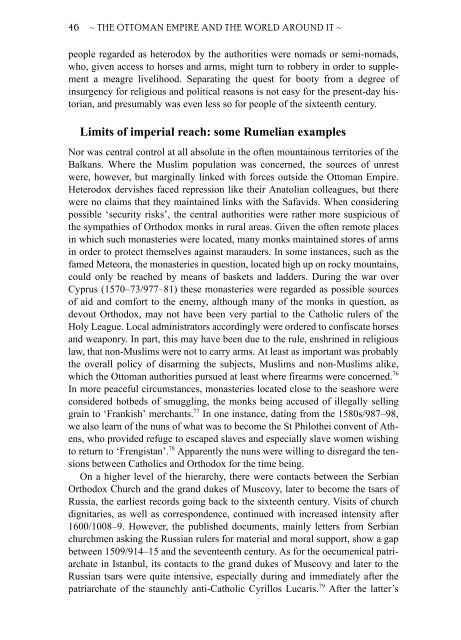The Ottoman Empire and the World Around It - Course Information
The Ottoman Empire and the World Around It - Course Information
The Ottoman Empire and the World Around It - Course Information
You also want an ePaper? Increase the reach of your titles
YUMPU automatically turns print PDFs into web optimized ePapers that Google loves.
46 ~ THE OTTOMAN EMPIRE AND THE WORLD AROUND IT ~<br />
people regarded as heterodox by <strong>the</strong> authorities were nomads or semi-nomads,<br />
who, given access to horses <strong>and</strong> arms, might turn to robbery in order to supplement<br />
a meagre livelihood. Separating <strong>the</strong> quest for booty from a degree of<br />
insurgency for religious <strong>and</strong> political reasons is not easy for <strong>the</strong> present-day historian,<br />
<strong>and</strong> presumably was even less so for people of <strong>the</strong> sixteenth century.<br />
Limits of imperial reach: some Rumelian examples<br />
Nor was central control at all absolute in <strong>the</strong> often mountainous territories of <strong>the</strong><br />
Balkans. Where <strong>the</strong> Muslim population was concerned, <strong>the</strong> sources of unrest<br />
were, however, but marginally linked with forces outside <strong>the</strong> <strong>Ottoman</strong> <strong>Empire</strong>.<br />
Heterodox dervishes faced repression like <strong>the</strong>ir Anatolian colleagues, but <strong>the</strong>re<br />
were no claims that <strong>the</strong>y maintained links with <strong>the</strong> Safavids. When considering<br />
possible ‘security risks’, <strong>the</strong> central authorities were ra<strong>the</strong>r more suspicious of<br />
<strong>the</strong> sympathies of Orthodox monks in rural areas. Given <strong>the</strong> often remote places<br />
in which such monasteries were located, many monks maintained stores of arms<br />
in order to protect <strong>the</strong>mselves against marauders. In some instances, such as <strong>the</strong><br />
famed Meteora, <strong>the</strong> monasteries in question, located high up on rocky mountains,<br />
could only be reached by means of baskets <strong>and</strong> ladders. During <strong>the</strong> war over<br />
Cyprus (1570–73/977–81) <strong>the</strong>se monasteries were regarded as possible sources<br />
of aid <strong>and</strong> comfort to <strong>the</strong> enemy, although many of <strong>the</strong> monks in question, as<br />
devout Orthodox, may not have been very partial to <strong>the</strong> Catholic rulers of <strong>the</strong><br />
Holy League. Local administrators accordingly were ordered to confiscate horses<br />
<strong>and</strong> weaponry. In part, this may have been due to <strong>the</strong> rule, enshrined in religious<br />
law, that non-Muslims were not to carry arms. At least as important was probably<br />
<strong>the</strong> overall policy of disarming <strong>the</strong> subjects, Muslims <strong>and</strong> non-Muslims alike,<br />
which <strong>the</strong> <strong>Ottoman</strong> authorities pursued at least where firearms were concerned. 76<br />
In more peaceful circumstances, monasteries located close to <strong>the</strong> seashore were<br />
considered hotbeds of smuggling, <strong>the</strong> monks being accused of illegally selling<br />
grain to ‘Frankish’ merchants. 77 In one instance, dating from <strong>the</strong> 1580s/987–98,<br />
we also learn of <strong>the</strong> nuns of what was to become <strong>the</strong> St Philo<strong>the</strong>i convent of A<strong>the</strong>ns,<br />
who provided refuge to escaped slaves <strong>and</strong> especially slave women wishing<br />
to return to ‘Frengistan’. 78 Apparently <strong>the</strong> nuns were willing to disregard <strong>the</strong> tensions<br />
between Catholics <strong>and</strong> Orthodox for <strong>the</strong> time being.<br />
On a higher level of <strong>the</strong> hierarchy, <strong>the</strong>re were contacts between <strong>the</strong> Serbian<br />
Orthodox Church <strong>and</strong> <strong>the</strong> gr<strong>and</strong> dukes of Muscovy, later to become <strong>the</strong> tsars of<br />
Russia, <strong>the</strong> earliest records going back to <strong>the</strong> sixteenth century. Visits of church<br />
dignitaries, as well as correspondence, continued with increased intensity after<br />
1600/1008–9. However, <strong>the</strong> published documents, mainly letters from Serbian<br />
churchmen asking <strong>the</strong> Russian rulers for material <strong>and</strong> moral support, show a gap<br />
between 1509/914–15 <strong>and</strong> <strong>the</strong> seventeenth century. As for <strong>the</strong> oecumenical patriarchate<br />
in Istanbul, its contacts to <strong>the</strong> gr<strong>and</strong> dukes of Muscovy <strong>and</strong> later to <strong>the</strong><br />
Russian tsars were quite intensive, especially during <strong>and</strong> immediately after <strong>the</strong><br />
patriarchate of <strong>the</strong> staunchly anti-Catholic Cyrillos Lucaris. 79 After <strong>the</strong> latter’s


